Report on the Developments in Juvenile Justice System in the USA
VerifiedAdded on 2021/04/17
|8
|1302
|59
Report
AI Summary
This report provides an in-depth analysis of the developments within the juvenile justice system in the U.S.A., concentrating on the impact of two significant landmark judgments: Roper v. Simmons and Miller v. Alabama. The report critically evaluates the court's reasoning in these cases, particularly concerning capital punishment and life imprisonment without parole for juvenile offenders. Furthermore, it offers recommendations for the administration of juvenile justice, aiming to create regulations beneficial to young offenders and their families while ensuring justice. The report also includes a reflection on the implications of these judgments, addressing the shift towards restorative justice and the importance of rehabilitation within the juvenile justice system. It emphasizes the need for legislation changes to influence the punishment and rehabilitation of juvenile offenders, including retrospective effects on judgments and changes in imprisonment processes.
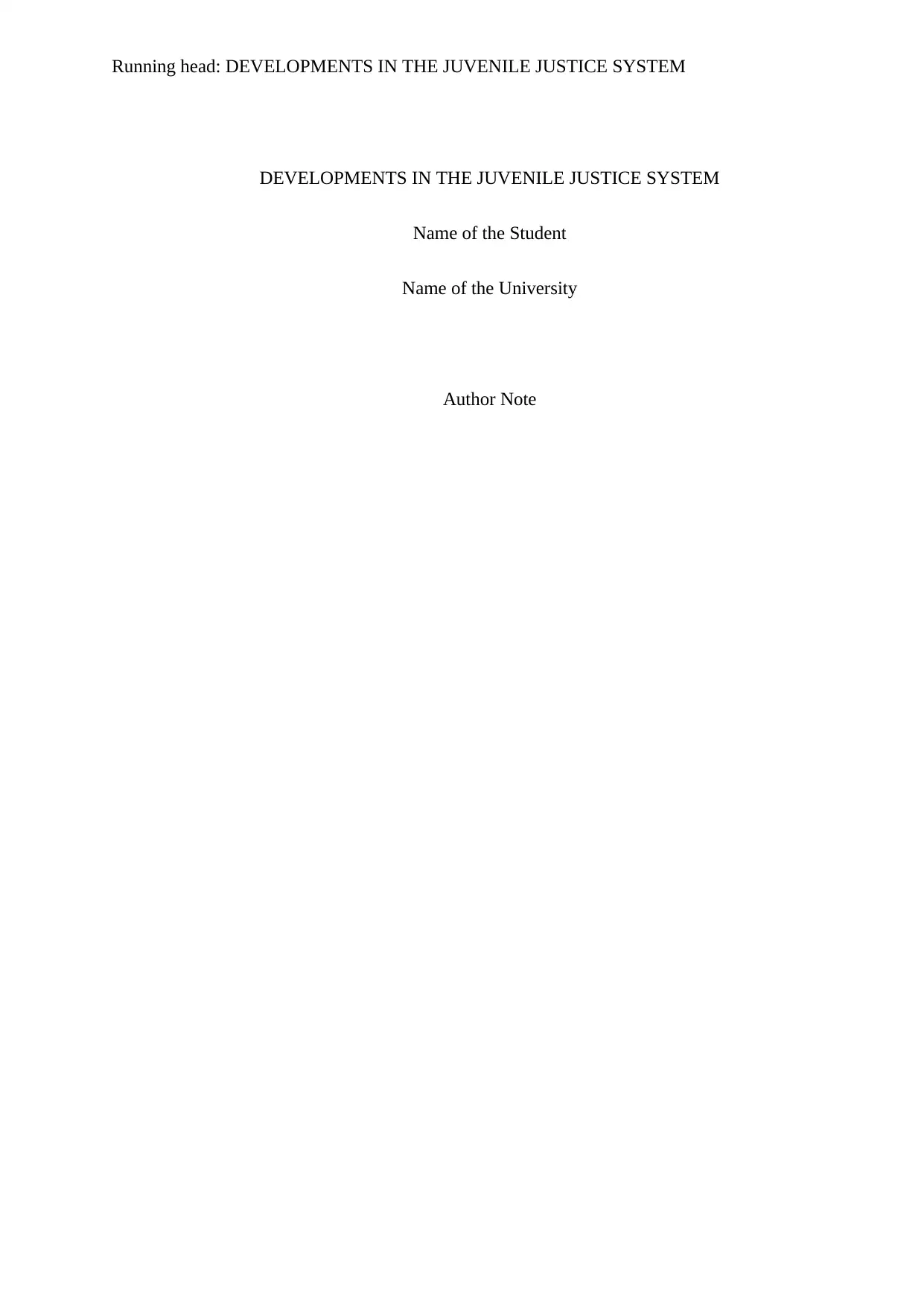
Running head: DEVELOPMENTS IN THE JUVENILE JUSTICE SYSTEM
DEVELOPMENTS IN THE JUVENILE JUSTICE SYSTEM
Name of the Student
Name of the University
Author Note
DEVELOPMENTS IN THE JUVENILE JUSTICE SYSTEM
Name of the Student
Name of the University
Author Note
Paraphrase This Document
Need a fresh take? Get an instant paraphrase of this document with our AI Paraphraser
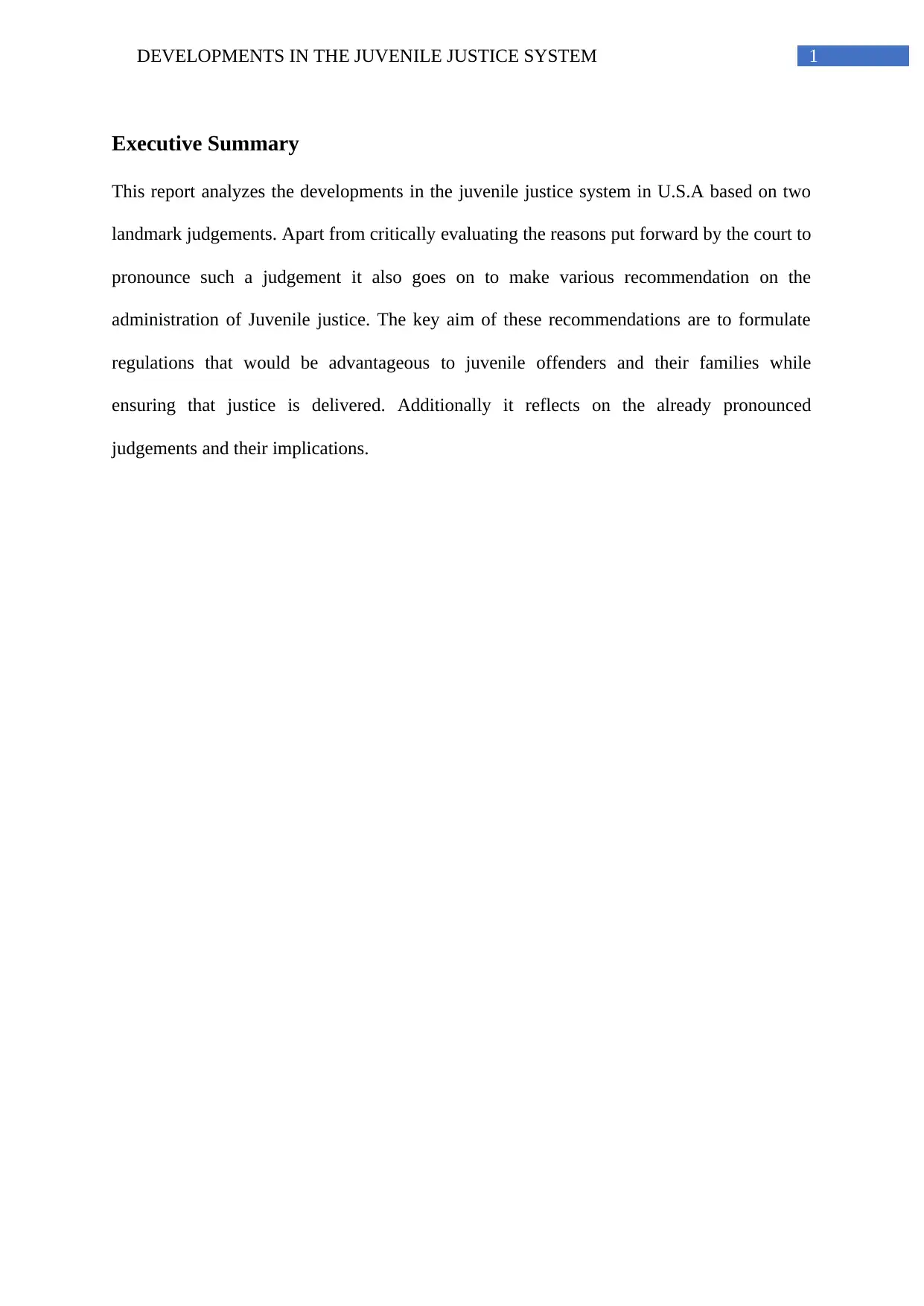
1DEVELOPMENTS IN THE JUVENILE JUSTICE SYSTEM
Executive Summary
This report analyzes the developments in the juvenile justice system in U.S.A based on two
landmark judgements. Apart from critically evaluating the reasons put forward by the court to
pronounce such a judgement it also goes on to make various recommendation on the
administration of Juvenile justice. The key aim of these recommendations are to formulate
regulations that would be advantageous to juvenile offenders and their families while
ensuring that justice is delivered. Additionally it reflects on the already pronounced
judgements and their implications.
Executive Summary
This report analyzes the developments in the juvenile justice system in U.S.A based on two
landmark judgements. Apart from critically evaluating the reasons put forward by the court to
pronounce such a judgement it also goes on to make various recommendation on the
administration of Juvenile justice. The key aim of these recommendations are to formulate
regulations that would be advantageous to juvenile offenders and their families while
ensuring that justice is delivered. Additionally it reflects on the already pronounced
judgements and their implications.
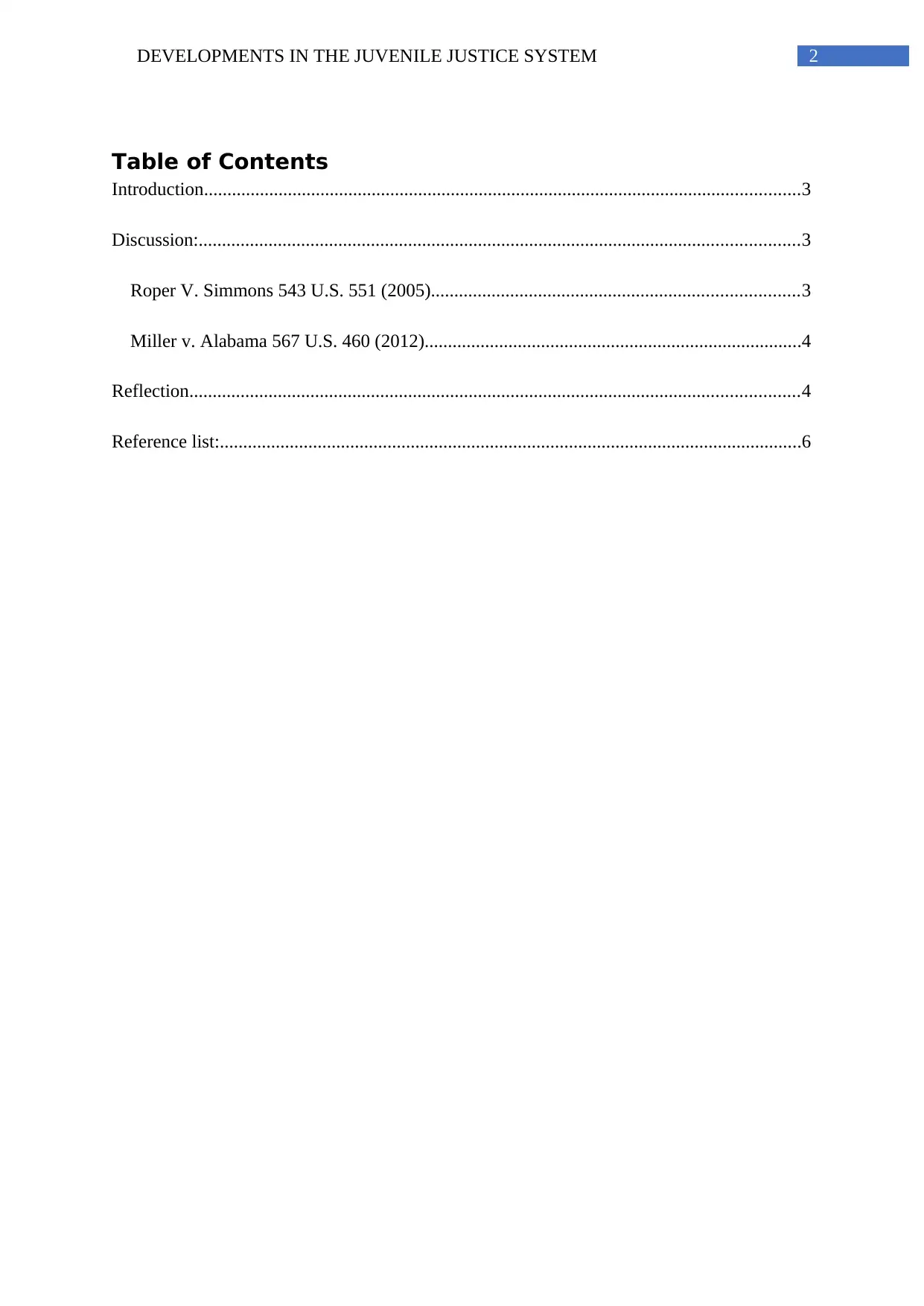
2DEVELOPMENTS IN THE JUVENILE JUSTICE SYSTEM
Table of Contents
Introduction................................................................................................................................3
Discussion:.................................................................................................................................3
Roper V. Simmons 543 U.S. 551 (2005)...............................................................................3
Miller v. Alabama 567 U.S. 460 (2012).................................................................................4
Reflection...................................................................................................................................4
Reference list:.............................................................................................................................6
Table of Contents
Introduction................................................................................................................................3
Discussion:.................................................................................................................................3
Roper V. Simmons 543 U.S. 551 (2005)...............................................................................3
Miller v. Alabama 567 U.S. 460 (2012).................................................................................4
Reflection...................................................................................................................................4
Reference list:.............................................................................................................................6
⊘ This is a preview!⊘
Do you want full access?
Subscribe today to unlock all pages.

Trusted by 1+ million students worldwide

3DEVELOPMENTS IN THE JUVENILE JUSTICE SYSTEM
Introduction
The term “juvenile” refers to a person who has not attained the age of majority.
Juvenile criminal offences are dealt with by Juvenile courts as opposed to criminal courts that
would normally take cognizance had the offence been committed by an adult (Sickmund &
Puzzanchera, 2014). However, there are various offences where a juvenile offender maybe
tried as an adult based on the gravity of the offence or a prolonged juvenile record (Messmer
& Otto, 2013). The following paragraphs will deal with the developments brought into
juvenile justice system by two landmark judgements.
Discussion:
Roper V. Simmons 543 U.S. 551 (2005)
In this landmark judgement the judgement pronounced in Stanford v. Kentucky was
overruled. The case before the Supreme Court was to uphold or quash the Supreme Court of
Missouri’s order of capital punishment awarded to a minor who was accused and convicted
of burglary and murder. Following the judgment in Atkins v. Virginia which laid down the
“evolving standards of decency” test the Court held that execution of juvenile offenders is
unconstitutional and hence the order of the Trial court was liable to be quashed (Wood et al.,
2014). To reach this conclusion the court first analyzed the previous applications of execution
orders of juvenile offenders. It concluded that any state that had previously awarded capital
punishment had since then abolished the same. Subsequently, it looked into cases where other
countries had awarded capital punishment to juvenile offenders and noted that countries like
Yemen, China and Nigeria which had awarded the death penalty to juvenile offenders
consequently rescinded the practice of the same. This lead to the Supreme Court’s final stand
on the issue. It must also be noted here that the defendant pleaded that the crime committed
Introduction
The term “juvenile” refers to a person who has not attained the age of majority.
Juvenile criminal offences are dealt with by Juvenile courts as opposed to criminal courts that
would normally take cognizance had the offence been committed by an adult (Sickmund &
Puzzanchera, 2014). However, there are various offences where a juvenile offender maybe
tried as an adult based on the gravity of the offence or a prolonged juvenile record (Messmer
& Otto, 2013). The following paragraphs will deal with the developments brought into
juvenile justice system by two landmark judgements.
Discussion:
Roper V. Simmons 543 U.S. 551 (2005)
In this landmark judgement the judgement pronounced in Stanford v. Kentucky was
overruled. The case before the Supreme Court was to uphold or quash the Supreme Court of
Missouri’s order of capital punishment awarded to a minor who was accused and convicted
of burglary and murder. Following the judgment in Atkins v. Virginia which laid down the
“evolving standards of decency” test the Court held that execution of juvenile offenders is
unconstitutional and hence the order of the Trial court was liable to be quashed (Wood et al.,
2014). To reach this conclusion the court first analyzed the previous applications of execution
orders of juvenile offenders. It concluded that any state that had previously awarded capital
punishment had since then abolished the same. Subsequently, it looked into cases where other
countries had awarded capital punishment to juvenile offenders and noted that countries like
Yemen, China and Nigeria which had awarded the death penalty to juvenile offenders
consequently rescinded the practice of the same. This lead to the Supreme Court’s final stand
on the issue. It must also be noted here that the defendant pleaded that the crime committed
Paraphrase This Document
Need a fresh take? Get an instant paraphrase of this document with our AI Paraphraser
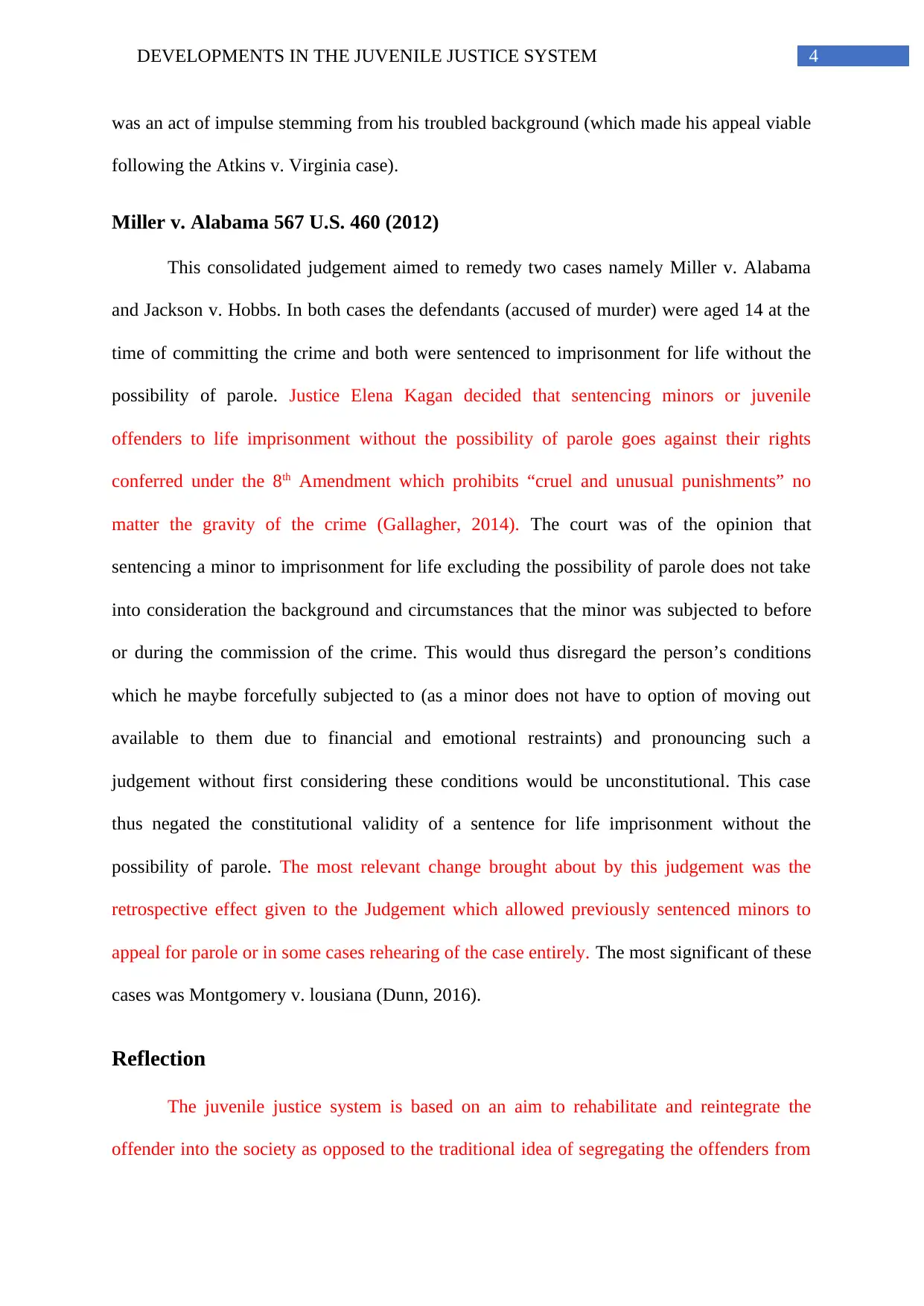
4DEVELOPMENTS IN THE JUVENILE JUSTICE SYSTEM
was an act of impulse stemming from his troubled background (which made his appeal viable
following the Atkins v. Virginia case).
Miller v. Alabama 567 U.S. 460 (2012)
This consolidated judgement aimed to remedy two cases namely Miller v. Alabama
and Jackson v. Hobbs. In both cases the defendants (accused of murder) were aged 14 at the
time of committing the crime and both were sentenced to imprisonment for life without the
possibility of parole. Justice Elena Kagan decided that sentencing minors or juvenile
offenders to life imprisonment without the possibility of parole goes against their rights
conferred under the 8th Amendment which prohibits “cruel and unusual punishments” no
matter the gravity of the crime (Gallagher, 2014). The court was of the opinion that
sentencing a minor to imprisonment for life excluding the possibility of parole does not take
into consideration the background and circumstances that the minor was subjected to before
or during the commission of the crime. This would thus disregard the person’s conditions
which he maybe forcefully subjected to (as a minor does not have to option of moving out
available to them due to financial and emotional restraints) and pronouncing such a
judgement without first considering these conditions would be unconstitutional. This case
thus negated the constitutional validity of a sentence for life imprisonment without the
possibility of parole. The most relevant change brought about by this judgement was the
retrospective effect given to the Judgement which allowed previously sentenced minors to
appeal for parole or in some cases rehearing of the case entirely. The most significant of these
cases was Montgomery v. lousiana (Dunn, 2016).
Reflection
The juvenile justice system is based on an aim to rehabilitate and reintegrate the
offender into the society as opposed to the traditional idea of segregating the offenders from
was an act of impulse stemming from his troubled background (which made his appeal viable
following the Atkins v. Virginia case).
Miller v. Alabama 567 U.S. 460 (2012)
This consolidated judgement aimed to remedy two cases namely Miller v. Alabama
and Jackson v. Hobbs. In both cases the defendants (accused of murder) were aged 14 at the
time of committing the crime and both were sentenced to imprisonment for life without the
possibility of parole. Justice Elena Kagan decided that sentencing minors or juvenile
offenders to life imprisonment without the possibility of parole goes against their rights
conferred under the 8th Amendment which prohibits “cruel and unusual punishments” no
matter the gravity of the crime (Gallagher, 2014). The court was of the opinion that
sentencing a minor to imprisonment for life excluding the possibility of parole does not take
into consideration the background and circumstances that the minor was subjected to before
or during the commission of the crime. This would thus disregard the person’s conditions
which he maybe forcefully subjected to (as a minor does not have to option of moving out
available to them due to financial and emotional restraints) and pronouncing such a
judgement without first considering these conditions would be unconstitutional. This case
thus negated the constitutional validity of a sentence for life imprisonment without the
possibility of parole. The most relevant change brought about by this judgement was the
retrospective effect given to the Judgement which allowed previously sentenced minors to
appeal for parole or in some cases rehearing of the case entirely. The most significant of these
cases was Montgomery v. lousiana (Dunn, 2016).
Reflection
The juvenile justice system is based on an aim to rehabilitate and reintegrate the
offender into the society as opposed to the traditional idea of segregating the offenders from
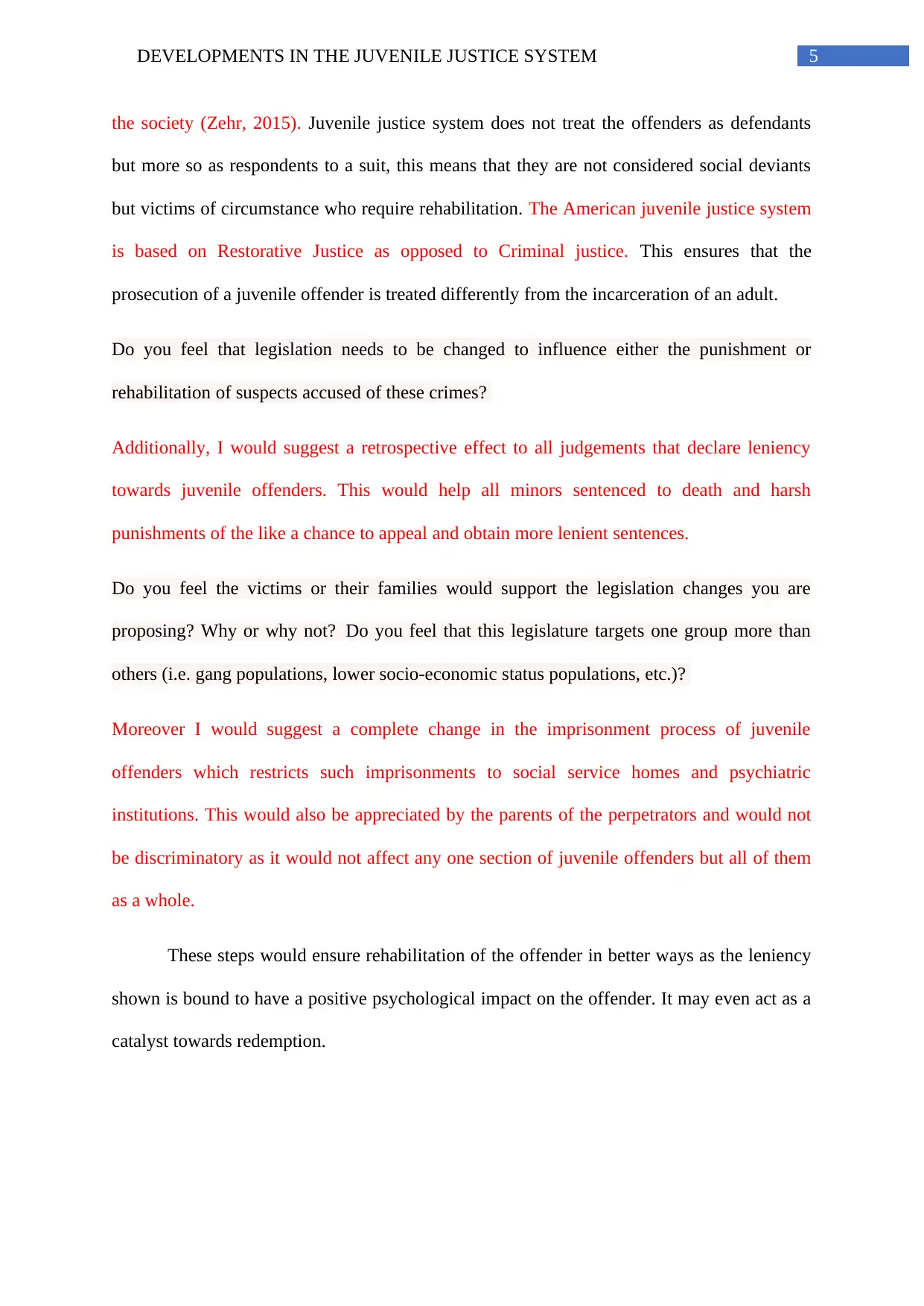
5DEVELOPMENTS IN THE JUVENILE JUSTICE SYSTEM
the society (Zehr, 2015). Juvenile justice system does not treat the offenders as defendants
but more so as respondents to a suit, this means that they are not considered social deviants
but victims of circumstance who require rehabilitation. The American juvenile justice system
is based on Restorative Justice as opposed to Criminal justice. This ensures that the
prosecution of a juvenile offender is treated differently from the incarceration of an adult.
Do you feel that legislation needs to be changed to influence either the punishment or
rehabilitation of suspects accused of these crimes?
Additionally, I would suggest a retrospective effect to all judgements that declare leniency
towards juvenile offenders. This would help all minors sentenced to death and harsh
punishments of the like a chance to appeal and obtain more lenient sentences.
Do you feel the victims or their families would support the legislation changes you are
proposing? Why or why not? Do you feel that this legislature targets one group more than
others (i.e. gang populations, lower socio-economic status populations, etc.)?
Moreover I would suggest a complete change in the imprisonment process of juvenile
offenders which restricts such imprisonments to social service homes and psychiatric
institutions. This would also be appreciated by the parents of the perpetrators and would not
be discriminatory as it would not affect any one section of juvenile offenders but all of them
as a whole.
These steps would ensure rehabilitation of the offender in better ways as the leniency
shown is bound to have a positive psychological impact on the offender. It may even act as a
catalyst towards redemption.
the society (Zehr, 2015). Juvenile justice system does not treat the offenders as defendants
but more so as respondents to a suit, this means that they are not considered social deviants
but victims of circumstance who require rehabilitation. The American juvenile justice system
is based on Restorative Justice as opposed to Criminal justice. This ensures that the
prosecution of a juvenile offender is treated differently from the incarceration of an adult.
Do you feel that legislation needs to be changed to influence either the punishment or
rehabilitation of suspects accused of these crimes?
Additionally, I would suggest a retrospective effect to all judgements that declare leniency
towards juvenile offenders. This would help all minors sentenced to death and harsh
punishments of the like a chance to appeal and obtain more lenient sentences.
Do you feel the victims or their families would support the legislation changes you are
proposing? Why or why not? Do you feel that this legislature targets one group more than
others (i.e. gang populations, lower socio-economic status populations, etc.)?
Moreover I would suggest a complete change in the imprisonment process of juvenile
offenders which restricts such imprisonments to social service homes and psychiatric
institutions. This would also be appreciated by the parents of the perpetrators and would not
be discriminatory as it would not affect any one section of juvenile offenders but all of them
as a whole.
These steps would ensure rehabilitation of the offender in better ways as the leniency
shown is bound to have a positive psychological impact on the offender. It may even act as a
catalyst towards redemption.
⊘ This is a preview!⊘
Do you want full access?
Subscribe today to unlock all pages.

Trusted by 1+ million students worldwide
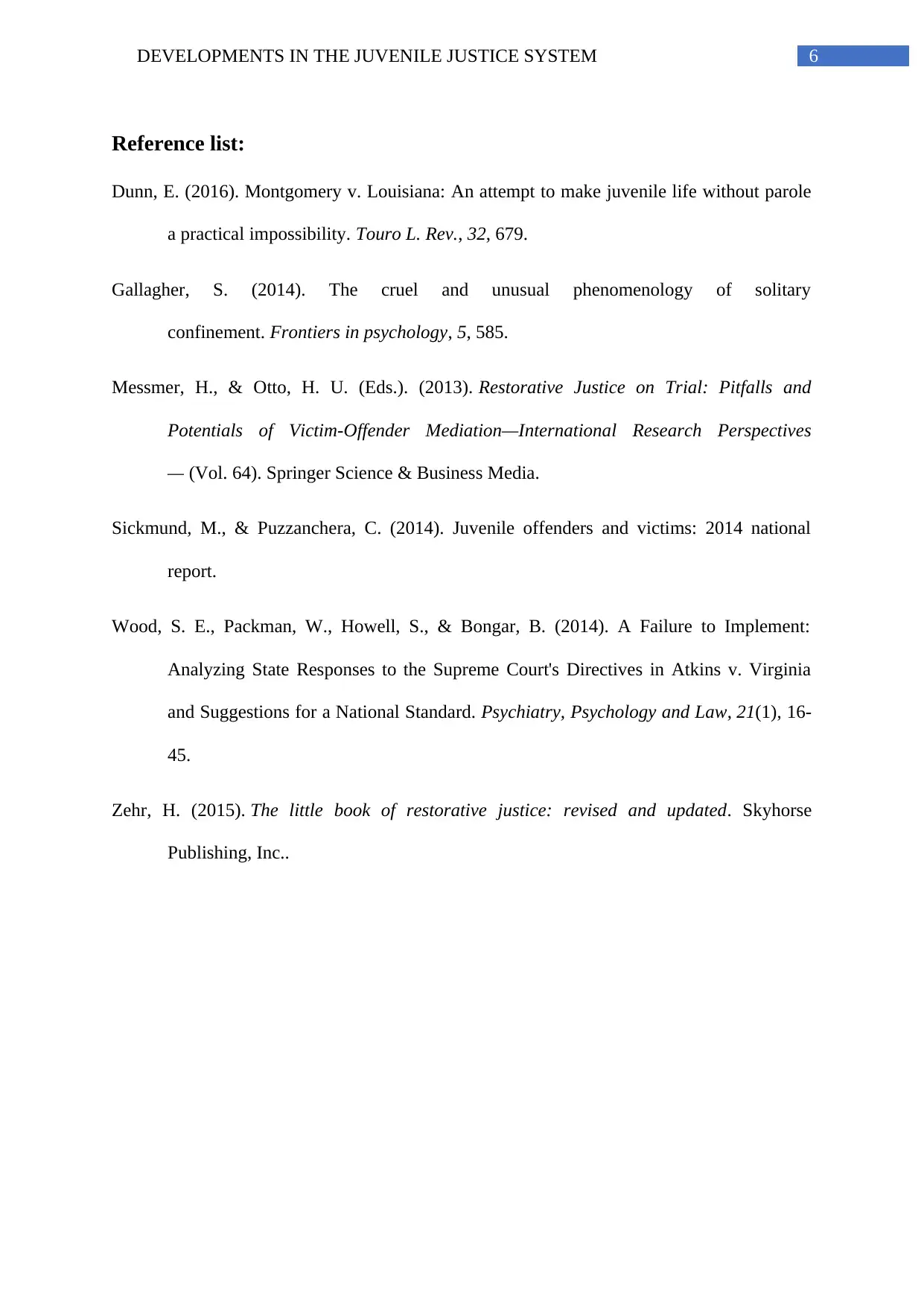
6DEVELOPMENTS IN THE JUVENILE JUSTICE SYSTEM
Reference list:
Dunn, E. (2016). Montgomery v. Louisiana: An attempt to make juvenile life without parole
a practical impossibility. Touro L. Rev., 32, 679.
Gallagher, S. (2014). The cruel and unusual phenomenology of solitary
confinement. Frontiers in psychology, 5, 585.
Messmer, H., & Otto, H. U. (Eds.). (2013). Restorative Justice on Trial: Pitfalls and
Potentials of Victim-Offender Mediation—International Research Perspectives
— (Vol. 64). Springer Science & Business Media.
Sickmund, M., & Puzzanchera, C. (2014). Juvenile offenders and victims: 2014 national
report.
Wood, S. E., Packman, W., Howell, S., & Bongar, B. (2014). A Failure to Implement:
Analyzing State Responses to the Supreme Court's Directives in Atkins v. Virginia
and Suggestions for a National Standard. Psychiatry, Psychology and Law, 21(1), 16-
45.
Zehr, H. (2015). The little book of restorative justice: revised and updated. Skyhorse
Publishing, Inc..
Reference list:
Dunn, E. (2016). Montgomery v. Louisiana: An attempt to make juvenile life without parole
a practical impossibility. Touro L. Rev., 32, 679.
Gallagher, S. (2014). The cruel and unusual phenomenology of solitary
confinement. Frontiers in psychology, 5, 585.
Messmer, H., & Otto, H. U. (Eds.). (2013). Restorative Justice on Trial: Pitfalls and
Potentials of Victim-Offender Mediation—International Research Perspectives
— (Vol. 64). Springer Science & Business Media.
Sickmund, M., & Puzzanchera, C. (2014). Juvenile offenders and victims: 2014 national
report.
Wood, S. E., Packman, W., Howell, S., & Bongar, B. (2014). A Failure to Implement:
Analyzing State Responses to the Supreme Court's Directives in Atkins v. Virginia
and Suggestions for a National Standard. Psychiatry, Psychology and Law, 21(1), 16-
45.
Zehr, H. (2015). The little book of restorative justice: revised and updated. Skyhorse
Publishing, Inc..
Paraphrase This Document
Need a fresh take? Get an instant paraphrase of this document with our AI Paraphraser

7DEVELOPMENTS IN THE JUVENILE JUSTICE SYSTEM
1 out of 8
Your All-in-One AI-Powered Toolkit for Academic Success.
+13062052269
info@desklib.com
Available 24*7 on WhatsApp / Email
![[object Object]](/_next/static/media/star-bottom.7253800d.svg)
Unlock your academic potential
Copyright © 2020–2025 A2Z Services. All Rights Reserved. Developed and managed by ZUCOL.

